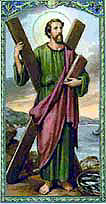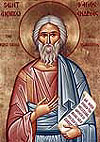November:St Andrew's Day(圣安德鲁日)
(单词翻译:单击)
| St Andrew's Day |
| November 30th |
|
St Andrew has been associated with Scotland for more than a millennium1. Legend has it that relics2 of the Apostle, who was crucified in Patras in Greece, were first brought to Scotland as early as the A monk3 known as St Rule (or St Regulus) dreamt that St Andrew's remains4 were to be moved from their tomb and on the directions of an angel took them as far away as he could for safe-keeping. After a lengthy5 voyage St Rule was shipwrecked on the east coast of Scotland at Muckross, (later Cill Rimhinn and now St Andrews) in Fife where, with the support of a Pictish king, he is said to have established a church and created the link between St Andrew and Scotland. An alternative explanation is that the relics were brought to St Andrews by the Bishop6 of Hexham who gave them to the Pictish King Angus. Either way St Andrews became a major religious centre and St Andrew's relics were enshrined within a church there. They were later kept within the magnificent confines of the great Cathedral of St Andrews. The link between Scotland and St Andrew is also evident in another legend which offers an explanation of the adoption7 of the cross of St Andrew as the basis for the Scottish national flag. When St Andrew was martyred he is said to have been crucified on an X-shaped cross as he believed himself unworthy of dying in the same way as Christ. Centuries later just before an important battle St Andrew appeared in a dream to King Angus and told him victory was his. On the day of the battle itself a white X-shaped cross appeared against the blue sky in front of the king's army. Believing they had God and St Andrew on their side the Pictish army was indeed victorious8. A grateful King Angus donated a tenth of his wealth to the glory of St Andrew and encouraged the dedication9 of churches to the Apostle. He was also later baptized by St Regulus at St Andrews. More relics of St Andrew, who was a brother of St Peter, were given to Scotland in 1874 and again in 1969 by the Vatican. St Andrew's Day may be fundamentally a religious day devoted10 to remembering the first Apostle but it has now also become a day dedicated11 to celebrating Scottish traditions and culture. St Andrew's Day festivities in Scotland and abroad frequently feature Scottish traditional food, music, songs, poetry and dance. |
 收听单词发音
收听单词发音
1
millennium

|
|
| n.一千年,千禧年;太平盛世 | |
参考例句: |
|
|
|
2
relics

|
|
| [pl.]n.遗物,遗迹,遗产;遗体,尸骸 | |
参考例句: |
|
|
|
3
monk

|
|
| n.和尚,僧侣,修道士 | |
参考例句: |
|
|
|
4
remains

|
|
| n.剩余物,残留物;遗体,遗迹 | |
参考例句: |
|
|
|
5
lengthy

|
|
| adj.漫长的,冗长的 | |
参考例句: |
|
|
|
6
bishop

|
|
| n.主教,(国际象棋)象 | |
参考例句: |
|
|
|
7
adoption

|
|
| n.采用,采纳,通过;收养 | |
参考例句: |
|
|
|
8
victorious

|
|
| adj.胜利的,得胜的 | |
参考例句: |
|
|
|
9
dedication

|
|
| n.奉献,献身,致力,题献,献辞 | |
参考例句: |
|
|
|
10
devoted

|
|
| adj.忠诚的,忠实的,热心的,献身于...的 | |
参考例句: |
|
|
|
11
dedicated

|
|
| adj.一心一意的;献身的;热诚的 | |
参考例句: |
|
|
|

 seventh or eighth century.
seventh or eighth century.



